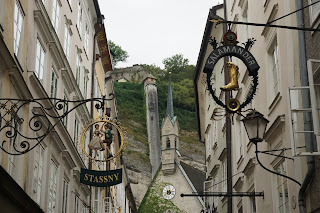September 5, 2015
Before breakfast we took the subway to a local laundry to freshen up some of our clothes. While Aimee figured out how to work these German appliances, I went in search of coffee and chocolate croissants.
Afterwards, we took the tram southeast to Nuremberg’s Documentation Center. Nuremberg has one of these history museums because the Nazis held annual Party Rallies here. I have seen them on old newsreels. They were not just meetings of a few top officials. The Rallies were week-long staged events with 500,000 participants. Theatrics and marching were emphasized.

The Nazis planned a number of colossal structures here, but the war halted construction of most. The museum is in a wing of the large unfinished Congress Hall, an amphitheater-like structure that would have held 50,000 people. From Obersalzberg, we know these Nazi museums have little English, so we get the Audio Guide. It takes us several hours to go through the exhibits. The museum covers the history of the Nazi Party and its rise to power. It concentrates on the party rallies. Hitler staged them here, at the old unofficial capital of the Holy Roman Empire, to help legitimize his Third Reich and were an important part of his propaganda campaign. While interesting, Aimee and I were led to believe there would be more information on how Hitler gained such devoted following by the German people. Hitler employed a lot of the techniques that modern politicians use today, like writing a book, staging a movie, hiring PR experts, and quashing any contrary opinions.

After the museum we walked the huge Rally Grounds. The main stop is Zeppelin Field. This is where most of the marching took place. It has a large grandstand, famous for having its big Swastika blown up on film by the US Army in 1945. The Rally Grounds are now used by the local community. Today, Zeppelin Field is overrun with German Shepherds in some kind of dog show. Ironic, since this dog was the favorite of the SS. In another part of the rally ground known as the Great Road, a large carnival is being held.
Back in Nuremberg Old Town, we have dinner at BarFusser, the large beer hall by our hotel. We have the local Nuremberg sausage. They are about a third the normal size but you get lots more of them.










































